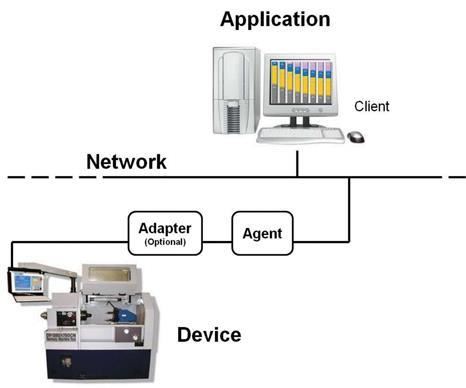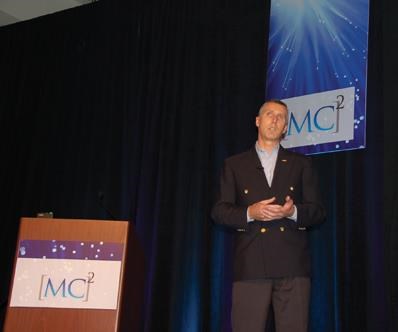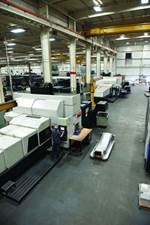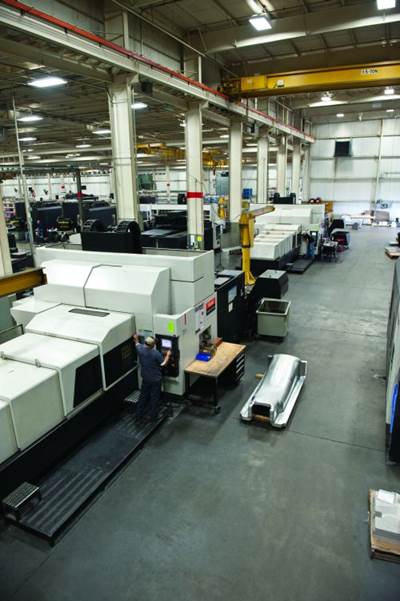Understanding MTConnect Agents and Adapters
MTConnect agents and their corresponding device adapters are simply small computer programs that work together so that MTConnect can make shop equipment and networks more readily connectible. In a nutshell, adapters enable existing shopfloor devices “to speak MTConnect,” and agents enable MTConnect messages and data files to be transmitted across a network to MTConnect-compatible applications.
MTConnect is an open-source, royalty-free communication protocol designed to make it easier for machine tools and other pieces of shopfloor equipment to talk to one another and to other computer programs that process shop data. This capability opens the door for true computer-integrated manufacturing.
In November 2011, the MTConnect Institute sponsored the first “MTConnect: Connecting Manufacturing Conference” (MC2) to bring together equipment suppliers, software developers and both current and potential users. The event was organized to promote the MTConnect standard by serving business managers as well as technical personnel. In the exhibit area, a number of suppliers showcased their MTConnect-compliant products, such as software applications and control systems. Conference sessions highlighted case histories of successful implementations by current users, especially for creating comprehensive shop monitoring systems.
One issue, however, seemed to be a sticking point for some potential users—the need for “adapters” and “agents.” Newcomers to MTConnect are often a bit mystified by these terms. The purpose of these software utilities can be confusing at first, and their role in implementing MTConnect may seem to be an obstacle.
Sensing these concerns among attendees, conference leaders quickly responded with reassurances that these programs are not difficult to understand or apply. Once explained, agents and adapters are readily accepted as practical elements that MTConnect needs to fit things together. Almost all shops will find that acquiring or creating these utilities is well within their means. MTConnect is an open-source standard that uses programming languages and networking protocols most programmers and software developers already understand.
In fact, at one of the workshops conducted at the conference, attendees were able to walk through the process of constructing adapters and agents. This took less than two hours. Under the guidance of the workshop leader, experienced programmers were able to write a usable adapter during this session.
Overall, the conference did make it clear that manufacturers should keep their focus on the benefits of MTConnect as a standard for factory floor communication. Although the details of implementing MTConnect are important, the real value of the standard lies in making it easier to get critical data to shopfloor monitoring systems, scheduling routines, accounting systems and other computer applications. MTConnect is not an application; it is simply an enabler of systems and software solutions that have great potential to enhance productivity. That’s the payoff that makes this closer look at the underlying components of MTConnect worthwhile.
Simple Utilities With Important Jobs
MTConnect agents and their corresponding device adapters are simply small computer programs that work together so that MTConnect can make shop equipment and networks more readily connectible. In a nutshell, adapters enable existing shopfloor devices “to speak MTConnect,” and agents enable MTConnect messages and data files to be transmitted across a network to MTConnect-compatible applications.
Most shops and plants are already familiar with situations in which implementing a standard requires add-on interfaces or adapters to benefit from greater integration and/or automation. In fact, a quick comparison to a robotic carrousel attached to a machining center may be useful here. In this scenario, the carrousel is like the MTConnect agent. The machining center is like the software application that uses MTConnect shopfloor data.
Typically, every item handled by carrousel (such as cutting tools, workpiece blanks, probe styli and so on) requires the same style holder, so it will fit the stations of the carrousel’s racks or shelves as well fit the robot gripper. Items from different suppliers might need physical adapters to attach to the kind of holder required on the carrousel.
Adapting physical objects for the carrousel is a lot like what an MTConnect adapter does for data from equipment provided by different suppliers. The adapter makes the data ready by fitting it to the standard MTConnect definitions. Likewise, the MTConnect agent can be compared to the robotic carrousel itself. Because the cutting tools, styli, part blanks and so on are properly adapted, the carrousel is able to store, retrieve and deliver them to the machining center as needed. The MTConnect agent plays a similar role in storing, retrieving and delivering “properly adapted” data across a network for processing by software applications as needed.
Consider that, in this comparison, it’s the work of the machine tool and the software application that adds real value to shopfloor operations. Installing the robotic carrousel or implementing MTConnect is just the means to the end.
From The Beginning
When the original movement to create MTConnect started in 2006, the practical matters of implementing the standard on the shop floor were well understood by the first developers and promoters. The need for adapters and agents was apparent from the beginning. For example, adapters would be necessary because no MTConnect-compliant equipment would be immediately available when the standard was first introduced. In addition, enabling interoperability among existing equipment was a goal of developing the standard in the first place.
Of course, before MTConnect was proposed, shops were faced with the prospect of creating or acquiring separate, unique adapters or interfaces for every network connection, every software application and every device-to-device connection. This lack of a “plug-’n-play” standard for manufacturing created a situation that has been described by Dave Edstrom, president of the MTConnect Institute, as “adapter hell.” It made shopfloor integration difficult, time-consuming and expensive. Even basic shopfloor machine monitoring was out of reach for most shops, for example. With MTConnect, however, every device needs only one adapter matched to one agent to become connectable to all other MTConnect-compliant devices, networks and software applications. In a very real sense then, an MTConnect agent and its related device adapter serve as a universal interface to the rest of the digital world.
Likewise, agents designed specifically for MTConnect would be necessary because all computer network models require a similar set of rules to exchange messages and data files in an orderly fashion. MTConnect agents are simply Web servers that take data from a machine tool or other device (via an adapter if the device was not delivered as MTConnect-compliant by the OEM), convert that data to a network-ready format and make it available on the network.
Very early in the development of MTConnect, developers decided to use the same primary standards that built the World Wide Web: HTTP, XML and TCP/IP. This wise decision gave MTConnect a head start when its initial version was introduced in 2008. This decision also shaped the purpose and function of software utilities such as agents and adapters.
HTTP, or Hypertext Transfer Protocol, is the underlying protocol used by the World Wide Web to define how messages are formatted and transmitted. It also establishes what actions Web servers and browsers should take in response to various commands. When a user types a Web address into a browser’s locator window using a URL (Uniform Resource Locator) such as HTTP://www.mmsonline.com, the browser follows the rules of HTTP to send a command that directs a Web server to fetch and transmit the requested Webpage.
XML, or Extensible Markup Language, is a standard that defines a rather simple way to structure, store and transport numerical information on the Web. XML is readable by humans as well as machines. This simplicity makes it easy to create data that can be shared by different applications. XML is the most commonly used language for data exchange on the Web.
Together, HTTP and XML can be considered the fundamental protocol and data exchange language of the Internet’s World Wide Web. Because MTConnect uses these same technologies, it is inherently suitable for use on any Web-enabled network.
Finally, MTConnect is designed to be compatible with TCP/IP, or Transmission Control Protocol and Internet Protocol. TCP/IP is the protocol, or set of ground rules, by which most computers and other digital devices communicate when connected to the Internet or other networks.
Because MTConnect is all about making it easier for machine tools and other shop equipment to talk to each other and supply data to applications on a network, using proven and ready-made standards such as HTTP, XML and TCP/IP was logical, functionally proven and efficient.
So how does data generated by shopfloor equipment turn into XML files that can be transmitted via HTTP? And then how does this data become accessible to the network? This is where MTConnect adapters and agents step in.
The Adapter As “Converter Box”
We’ll start with details about adapters. Essentially, an adapter is a program specifically customized to convert device-specific data into the equivalent MTConnect-defined terminology for the particular agent that’s attached. The adapter acts as a kind of translator. Adapters are typically created by the manufacturing equipment provider, software vendor or an integrator. Because MTConnect is open source, it is possible for shops or plants that have experienced software writers to create an adapter. Strictly speaking, adapters are not covered in the MTConnect standard—they are an accommodation provided on the device side of the connection for purposes of implementation. This gives implementers many innovative options for how they structure and install the adapter.
That MTConnect has a set of defined terminology, a set that can be continuously enlarged with new word entries to cover additional types of shop equipment, is a key point. Having this “dictionary” ensures that data from machines or devices provided by many different suppliers will have the same meaning. Names, units, values and contexts will be consistent once they are “translated into MTConnect,” so to speak.
Consistent usage is a great advantage to end users because it enables them to understand what the data from the factory floor is telling them. For example, a software program designed to keep track of alarms and alerts coming from several machines needs to know if each different type of alarm or alert indicates the same type of happening or condition, regardless of its source. Otherwise, the program can’t make sense out of them to help the end user make sound decisions about a response. Following the MTConnect dictionary definitions settles this issue.
Being able to expand this dictionary is a key point, too. It makes the standard extensible. The manufacturing industry does not have to worry about MTConnect leaving out “old” technology or missing out on emerging new technology.
However, adapters generally have to be custom-written because the meaning, wording, units and values of data usually vary from machine to machine and device to device because it often follows a proprietary or supplier-specified format. The good thing is, once an adapter has been installed and interfaced to an agent, the machine or device doesn’t need any more adapters to connect with other MTConnect devices, networks or applications. This creates “adapter heaven,” as Mr. Edstrom characterizes it, and makes developing applications for manufacturing much more attractive to so
This is why proponents of MTConnect are making the development of adapters and the accompanying agents a priority. The MTConnect Institute, for example, has created a variety of tools and facilities to make it easy for users to create or acquire these software utilities. The Institute has a growing library of open-source adapters and the agents they reference, all contributed by end users or generous developers. These utilities can be freely downloaded and, in many cases, used “as is” or with only slight modification to serve the needs of other end users.
To be clear, creating adapters is not a trivial affair. The effort or difficulty involved depends partly on the accessibility of the data generated in the device and partly on access to information about how the device structures its data. For example, creating an adapter for a device that has a well-documented and comprehensive Application Programming Interface (API) is relatively easy. Other cases may require a higher level of programming skill and persistence.
Typically, the adapter is installed on the device’s control unit, such as a machine tool’s CNC (usually at the PC front end). Other options also exist, such as installing the agent on a networked PC or server.
However, some older machines or devices may not generate very much usable data to begin with. These cases require more than the adapter’s translating function. Some kind of “connection unit” is needed to generate certain data the shop wants to collect and analyze in another software application. Connection units usually provide a processor to run the adapter as well as sensors, monitoring devices or other hardware to generate readings or signals. Several suppliers exhibited their connection units at the MC2 conference, and it is already clear that connection-unit developers are being very inventive and imaginative.
This is great news. The availability of connection units will enable shops to connect a wide variety of devices to the network for feeding valuable applications. Looking ahead, “Any device that gets some type of power will be connectable to your shop network using MTConnect,” as one developer noted.
Secrets Of The Agent
As discussed above, the adapter makes an all-important connection by translating a device’s data into MTConnect-understandable terminology. (Note: adapters are not needed if the machine or device already generates data using the MTConnect definitions.)
Now, let’s get to MTConnect agents. The agent takes over where the adapter leaves off, so to speak. One main job of the agent is to format MTConnect data into XML. This is the format that allows data to be interpreted by almost all software applications designed to accept data from the Internet. The agent must also provide adequate buffer storage to hold data until applications request it. The size of the buffer can vary to suit the needs of the implementation.
Another important job for the agent is to provide an interface to the network so data can be accessed by outside applications. The agent does this by using HTTP to receive requests for data from applications, process those requests and transmit the requested data. MTConnect specifies a “probing function” in which a probe command submitted to the agent solicits information about the physical attributes of the manufacturing equipment and data items that can be retrieved. This helps the application set parameters for data exchange.
Similarly, the agent can take advantage of whatever type of networking connection exists at the device. This is usually a standard Ethernet interface, but other types of physical connections, such as serial ports, are also supported. The MTConnect standard does not specify the nature of these connections. The agent simply has to be set up for whatever type of connection is provided. The most important consideration is that once the connection is made, MTConnect makes it easy for the data to be acquired and used effectively downstream.
Like the adapter, the agent is a software program, but users have several options for where the agent is installed. For example, it might run on the same control unit computer where the adapter is installed, on a separate PC or workstation attached as a node on the network, or on a network file server that also runs a software application for shop monitoring or job
scheduling.
Some shops with well-established Information Technology (IT) departments and experienced programmers may choose to write their own MTConnect agents. Others may acquire the agent from the application provider, the machine tool builder or device supplier. Because MTConnect is open source, an increasing number of corresponding adapters and agents have been made freely available by other users.
Be Application Driven
We have looked under the hood to show how adapters and agents work together to bring connectivity to manufacturing equipment with MTConnect. Does this mean the shop owner or plant manager has to be an expert on adapters or agents? Certainly not. The best resource for evaluating an MTConnect implementation is “Getting Started With MTConnect—Connectivity Guide,” a clear overview intended for shop owners and plant managers. It puts agents and adapters into perspective.
Also consider these recommendations: When you are looking at software solutions, make sure the vendor supports MTConnect. When you are buying manufacturing equipment, make sure the vendor supports MTConnect.
Finally, as noted in the Connectivity Guide, having a valuable application in mind is a good starting point for learning more about MTConnect. Shop monitoring is one of the most popular applications right now. Simply knowing some basic facts about the status of machines on the shop floor has many benefits for owners and managers. Programs that track power consumption constitute another emerging category of applications attracting great interest.
Related Content
Machine Monitoring Boosts Aerospace Manufacturer's Utilization
Once it had a bird’s eye view of various data points across its shops, this aerospace manufacturer raised its utilization by 27% in nine months.
Read MoreGive Job Shop Digitalization a Customer Focus
Implementing the integrated digital technologies and automation that enhance the customer's experience should be a priority for job shops and contract manufacturers.
Read MoreCan Connecting ERP to Machine Tool Monitoring Address the Workforce Challenge?
It can if RFID tags are added. Here is how this startup sees a local Internet of Things aiding CNC machine shops.
Read MoreSwiss-Type Control Uses CNC Data to Improve Efficiency
Advanced controls for Swiss-type CNC lathes uses machine data to prevent tool collisions, saving setup time and scrap costs.
Read MoreRead Next
The Need to Know Is Basic
An MTConnect-enabled monitoring system gives this shop a clear and simple picture of machine tool usage.
Read MoreThe Need to Know Is Basic
An MTConnect-enabled monitoring system gives this shop a clear and simple picture of machine tool usage.
Read MoreThe Need to Know Is Basic
An MTConnect-enabled monitoring system gives this shop a clear and simple picture of machine tool usage.
Read More



















.png;maxWidth=300;quality=90)










